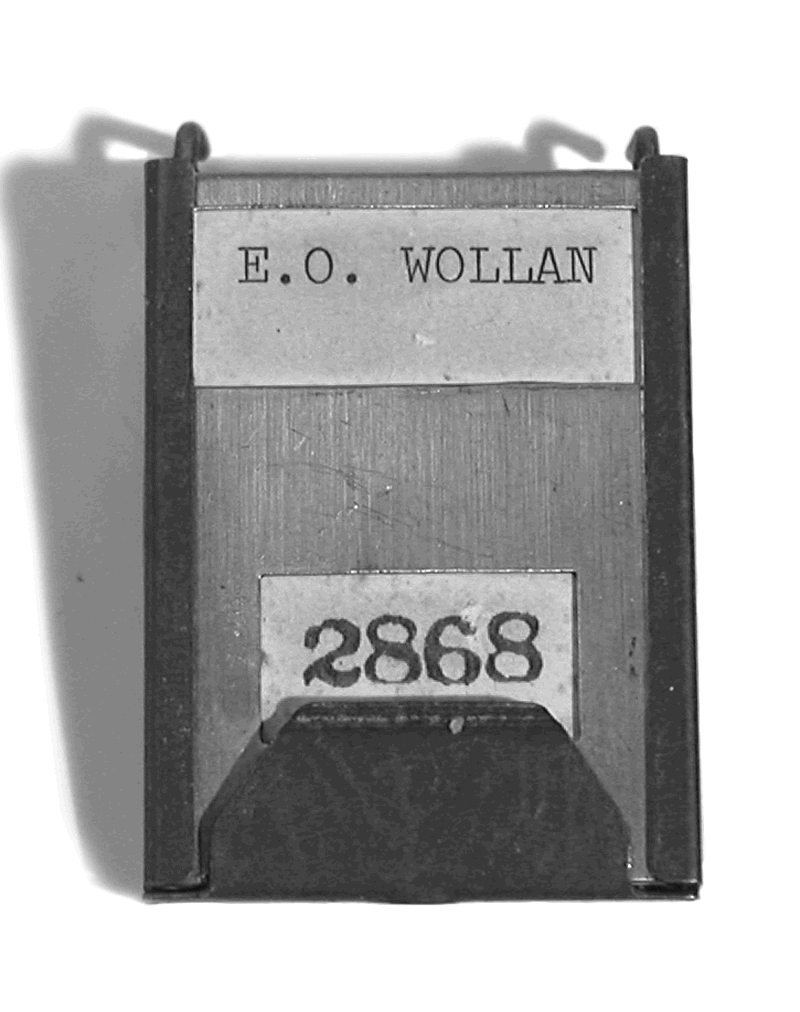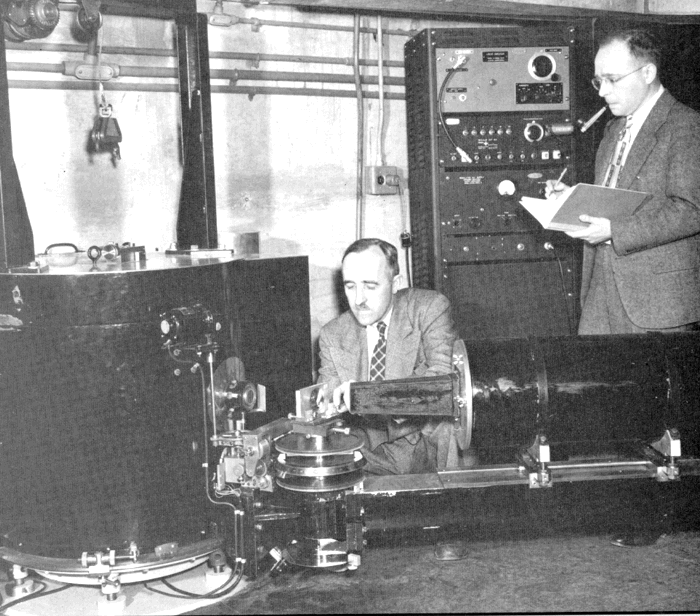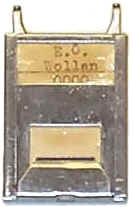Ernest Wollan's Film Badge from Manhattan Project (ca.1943)

This is an example of the film badge developed (pun intended) by Ernest Wollan for use at the University of Chicago's Metallurgical Laboratory during World War II.
Film had been used previously (as early as 1905) to evaluate radiation exposures, but in most cases the techniques were relatively primitive. For example, one method that was used well into the 1930s involved holding the developed film against a newspaper. If the newspaper could be read through the film, the exposure was low enough to be acceptable.
A key feature of the badge was that it employed filtration (1 mm cadmium) to reduce the variations in the film's response (accuracy) to radiation of different energies.
Wollan headed up the radiation protection program at Chicago during the Manhattan project and he was the first person to employ the title "Health Physicist."
It Belonged to Wollan
Paul Frame, Oak Ridge Associated Universities
This story appeared in two parts in the August and September 1996 issues of the Health Physics Society's Newsletter
Part One
My good friend Roger Cloutier came by the other day with a gift of classic literature: Radiations from Radioactive Substances by Rutherford, Chadwick, and Ellis (1930). Now, Cloutier, Rutherford, and Chadwick are familiar names, but who was this Ellis guy? A little investigative work revealed that Chadwick and Ellis met and began their collaborations while doing time together in prison. Chadwick, working in Germany with Hans Geiger when WWI broke out, was apprehended and locked up in a horse stall at a racetrack that served as an internment camp. Rather than study law as prisoners do nowadays, Chadwick studied physics. The assorted business and managerial types interned with Chadwick had little interest in science (no surprise there), so Chadwick worked alone—until a new P.O.W. joined the stable, C.D. Ellis of His Majesty’s Highland Regiment. He and Chadwick struck up a relationship and before long Ellis had been transformed into a physicist (McKown 1962). After the war, they went to Cambridge University to do great things, including coauthor (with Rutherford) Radiations from Radioactive Substances.
When Roger gave me the aforementioned book, I looked to see if a previous owner had left an inscription. Luckily, Roger didn’t share this habit because there, on the inside cover, was the name "E.O. Wollan." Yep, the E.O. Wollan! The first to use the title "health physicist!" As soon as I showed Roger, he remarked, "If I’d known, I wouldn’t have given it to you." I’ve since discovered that Wollan visited Chadwick shortly after the latter’s discovery of the neutron (Wollan 1980). Perhaps that’s when he obtained the book. Maybe Wollan even received it as a gift? Thanks Roger, you’re a great guy!
Not long after the start of WWII, the "Metallurgical Laboratory" (Met Lab) was established at the University of Chicago to carry out research for the atomic bomb project. The individual in charge was Arthur Compton and it is not surprising that he chose Ernest Wollan as one of the first to join the project: Wollan had received his doctorate investigating X-ray scattering from crystals under Compton’s supervision and the two had collaborated for a number of years investigating cosmic rays (Wollan 1980). The major focus of the Met Lab’s activities was the construction of CP-1 (Chicago Pile-1), the first nuclear pile, and Wollan’s initial task was to determine its shielding requirements.
From the beginning, it was clear that the range of radioisotopes and activities resulting from the project’s operations would be unlike anything previously encountered. Wollan was given the job of assembling and heading up a group of radiation protection specialists who formed what was known as the "Health Physics Section" of the Met Lab’s Health Division. They were the first to use the title "Health Physicist" and the first to fully devote their activities to the pursuit of radiation safety.
The potential radiation exposures to Met Lab personnel were high but there was no satisfactory way to quantify these exposures. Pocket ion chambers were prone to error, and as Wollan commented, the use of film as then practiced "left much to be desired." So in September of 1942, Wollan, together with Norm Goldstein, began developing techniques by which film could be used to accurately measure exposures. By late 1943, they began issuing the first standardized film badges which consisted of dental film packets covered with 1 mm cadmium filters to flatten the energy response (Hacker 1987).
Part Two
When that historic day arrived, 2 December 1942, fifty select individuals were inside the squash court at Stagg Field observing and/or assisting as Enrico Fermi’s nuclear pile, CP-1, powered up to achieve the first self-sustaining criticality. On the balcony overlooking the pile, Ernest Wollan had set up an electroscope to measure the gamma levels (Wollan 1980). The position of the electroscope fiber, automatically reset after each discharge, was continuously recorded by a movie camera—a method previously used in cosmic-ray studies for recording electroscope readings during balloon ascents.
Although Wollan is not always listed among those present when CP-1 went critical, he was there. But it seems he spent at least some of the time outside the stadium pounding the cold Chicago pavement with his survey instrument, assuring himself that his shielding calculations had not been in error. However, we can say that Carl Gamertsfelder, the second to employ the title "health physicist," was definitely inside the squash court when the first self-sustaining criticality was achieved. And Carl, oblivious to Wollan’s absence or presence, certainly drank Chianti courtesy of Eugene Wigner.
After WWII, Wollan moved to Oak Ridge to work with the Graphite Reactor (a.k.a. the X Pile, the Clinton Pile, or old grandma), which we Oak Ridgers know to have been the first real reactor—the things in Chicago were physics experiments. The graphite reactor was a prodigious source of neutrons, and Wollan wanted to determine if these neutrons could be used in the same way X-rays were used in diffraction studies.
He was soon joined by Clifford Shull, and together they developed the technique of neutron diffraction analysis for investigating crystal structure.
In 1994, 40-plus years later, Clifford Shull received the Nobel Prize in Physics for this work. The unusually long delay in awarding the prize was due to the politically incorrect association of neutron diffraction analysis with nuclear power, i.e., the method had been developed using a reactor. As Karl Larsson of the Swedish Academy of Sciences admitted (Strand 1994), "Politics should not affect us, but we are only human."
The award, because it is not given posthumously, came too late for Ernest Wollan—he died in 1984. The first "health physicist" didn’t live to receive the Nobel Prize that was rightfully his.

Ernest Wollan (left) and Clifford Shull (standing) working with their neutron diffraction unit at the Oak Ridge Graphite Reactor in 1950.
References
- Hacker, B.C. The dragon’s tail - radiation safety in the Manhattan project, 1942-46. Univ. of California Press; Berkeley; 1987.
- McKown, R. Giant of the atom - Ernest Rutherford. Julian Messner, Inc.; New York; 1962.
- Rutherford, E.; Chadwick, J.; Ellis, C.D. Radiations from radioactive substances. Cambridge Univ. Press; London; 1930.
- Strand, K. Associated Press News Release; Stockholm; 12 Oct. 1994.
- Wollan, E.O. The other record of the first nuclear reactor start-up. Am. J. Physics 48: 979-980; 1980.
The inspiration for the design was a film badge that Carl Braestrup had been deploying in New York City hospitals since the early 1930s. The problem that Braestrup had been faced with was that the device's accuracy depended on the energy of the photons (X-rays or gamma rays) to which it was exposed. In a hospital setting, a wide range of energies could be encountered: X-ray units emitted low energy photons whereas radium sources emitted some very high energy gamma rays. By incorporating metal filters into the badge, the photon energy could be estimated. Once the energy was known, any necessary corrections to the response of the film would be made.

This shows the version of Wollan's badge used at Oak Ridge National Laboratory ca. 1950. Note the number: 0000 (pretty cool).
At the start of World War II, Braestrup was contacted by some people at the Metallurgical Laboratory to find out if he had taken out a patent on the dosimeter. If he had done so, he would have become a very rich man, but he hadn't. In any event, the folk in Chicago used Braestrup’s design as the basis for the film badge used in the Manhattan Project (interview of Carl Braestrup in the BRH Vignettes of Early Radiation Workers).
References
- Pardue, Goldstein and Wollan, Photographic Film as a Pocket Dosimeter, Metallurgical Laboratory Report CH-1553, April, 1944.
- US Patent 2,483,991 Radiation Exposure Meter, Ernest Wollan, and Louis Pardue.
- Personal communication, Herb Pomerance.
